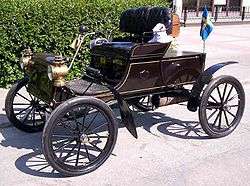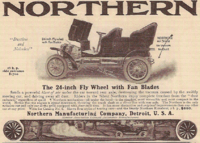Northern (automobile)
 | |
| Automobile Manufacturing | |
| Industry | Automotive |
| Genre | Roadsters, touring cars, limousines, runabouts[1] |
| Headquarters | Detroit, Michigan,, United States |
Area served | United States |
| Products |
Automobiles Automotive parts |

Northern Manufacturing Company was a manufacturer of Brass Era automobiles in Detroit, Michigan, automobiles designed by Charles Brady King.[2]
History
The 1904 Northern was a runabout model. It could seat 2 passengers and sold for US $750 ($18,460 in 2007). The flat-mounted water-cooled single-cylinder engine, situated at the center of the car, produced 6 hp (4.5 kW). A 2-speed transmission was fitted. The tubular-framed car weighed 950 lb (431 kg) and used Concord springs.[2] In 1902 Charles B. King and Jonathan Maxwell created the Northern Manufacturing Company, which went on to be the parent company of Studebaker and grandparent company of Chrysler. Maxwell would later become a well-known name as a line of automobiles would bear his name. King would not experience that same level of fame, though he is remembered as the first person to drive an internal combustion car on the streets of Detroit.[3]
Though the automobile industry was in its infancy, both of these men had already compiled a resume of automotive experience. Both had worked for R. E. Olds. King, who had an engineering degree from Cornell and had moved to Detroit in 1891, was the chief designer at Oldsmobile but left the company after the 1901 fire at the plant. Four years after moving to Detroit, he formed the American Motor League to promote good roads. His first car was created in 1896, and was immediately driven on the streets, much to the dismay of other travelers. The new contraption was loud (as were most other vehicles of the time) and disturbed the horse-drawn carriages. Henry Ford's first vehicle was built three months after King’s.[4]
Maxwell had produced a single-cylinder 5-horsepower engine which was used to power the new Northern automobiles. The design was similar to that of the Oldsmobile's and with the relatively advanced engine, the vehicles gained a reputation as “Silent Northern.”
In 1903 the company produced 300 examples of the runabout, and in 1904 expanded their offerings with the introduction of a twin-cylinder Touring model. In 1903, Maxwell was lured away by Benjamin Briscoe, and the Maxwell-Briscoe Motor Company in Tarrytown, New York, was formed. The Maxwell car was introduced in 1905. Maxwell was absorbed into the newly created Chrysler Corporation in 1925.
King remained at Northern, continually improving the capabilities of the car. A twin-cylinder, shaft drive unit was introduced, followed by a four-cylinder engine in 1906. By 1907, the single-cylinder cars were discontinued. King left Northern in 1908, but by then, the company was in precarious shape. It was soon taken over by the Wayne Automobile Company, which was quickly acquired by E-M-F, which became Studebaker in 1913.
Advertisements
 1905 Northern Advertisement |
 Northern Motor Car Company, 1906 |
References
- ↑ Automotive Industries, Vol. 12. The Class Journal Co., 1906. Retrieved August 5, 2011.
- 1 2 Frank Leslie. Frank Leslie's Popular Monthly. January 1904.
- ↑ "Charles B. King pioneered horseless carriages Henry Ford was a mere tot when King tested his car in Detroit". Lookupdetroit.com. 2010-04-30. Retrieved 2011-05-19.
- ↑ "The River that changed the World". Motorcities.org. Retrieved 2011-05-19.
External links
- Early AmericanAutomobiles Homepage has the picture of a 1904 Northern Tonneau (scroll to mid-page)